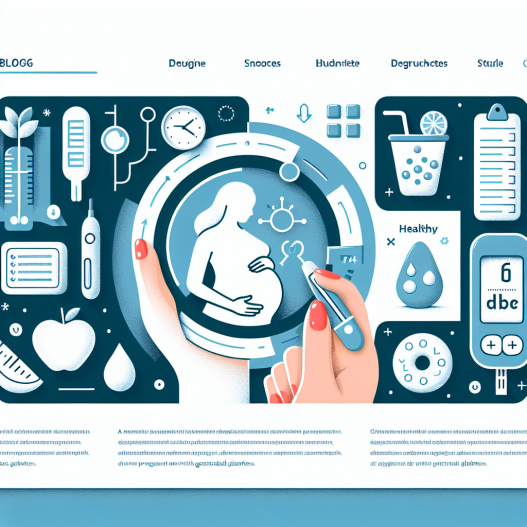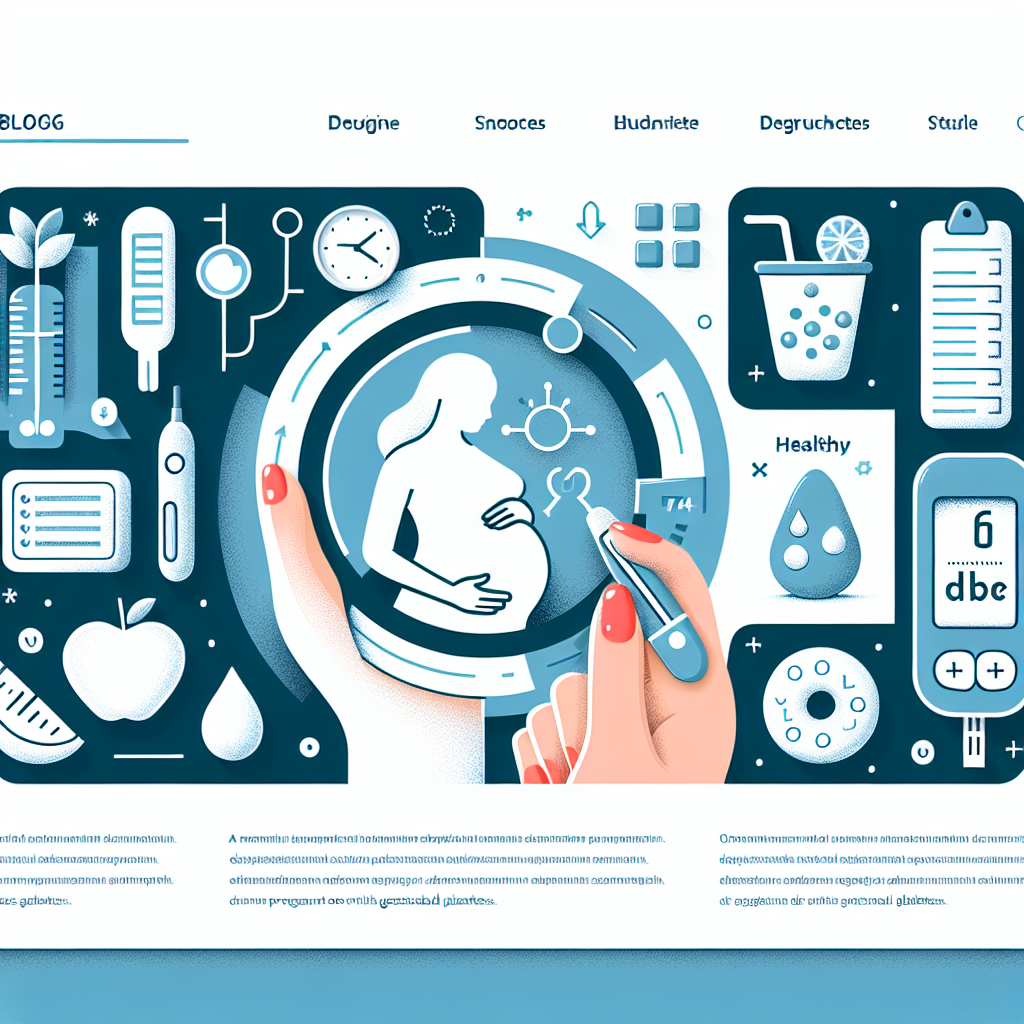[ad_1]
Managing blood sugar levels is critical for pregnant women diagnosed with gestational diabetes. This condition affects how the body utilizes glucose during pregnancy, potentially impacting both maternal and fetal health. Monitoring blood sugar levels not only aids in managing gestational diabetes but also plays a vital role in ensuring a healthy pregnancy and reducing the risk of complications. In this comprehensive guide, we will dive deep into the importance of blood sugar monitoring and provide valuable insights and techniques specifically tailored for expectant mothers dealing with this condition.
Understanding Gestational Diabetes and Its Impact on Pregnancy
Gestational diabetes is a type of diabetes that occurs during pregnancy. It typically develops when the body cannot produce enough insulin to meet the extra demands of pregnancy, leading to higher blood glucose levels. Understanding how gestational diabetes affects both the mother and the baby is essential for effective monitoring and management.
The condition generally develops in the second or third trimester and can lead to several complications if not properly managed. For the mother, the risks include elevated blood pressure, the development of preeclampsia, and a higher likelihood of developing Type 2 diabetes later in life. For the baby, gestational diabetes may lead to excessive growth (macrosomia), which increases the chances of a cesarean delivery and the likelihood of the baby developing obesity and Type 2 diabetes in the future.
Monitoring blood sugar levels will help ensure that both mother and baby remain healthy. Regular checks provide accurate insights into how well glucose levels are controlled and can help guide dietary and lifestyle choices that are crucial during pregnancy.
Why Monitoring Blood Sugar Levels Is Crucial
Regularly monitoring blood sugar levels is a cornerstone of managing gestational diabetes. By keeping a close watch on glucose levels, mothers can understand how their bodies react to different foods, activities, and stressors. This individualized approach allows for better decision-making regarding diet, exercise, and medication if necessary.
Additionally, consistent monitoring can help prevent fluctuations in blood sugar levels that can lead to complications for both the mother and the baby. For instance, high blood sugar levels can increase the risk of infant complications like jaundice, low blood sugar, and respiratory distress after birth. By actively managing blood glucose levels, mothers can significantly reduce these risks, providing a safer environment for their babies both during pregnancy and post-delivery.
Moreover, monitoring blood sugar levels gives women the opportunity to take an active role in their health care. It empowers them with information that can lead to collaborative discussions with healthcare providers regarding their treatment plans. By staying informed, pregnant women can make empowered choices that enhance their well-being and that of their unborn child.
How to Monitor Blood Sugar Levels Effectively
For pregnant women with gestational diabetes, effective monitoring typically involves using a blood glucose meter. This device measures the amount of glucose in the bloodstream, allowing women to track their levels throughout the day. Typically, your healthcare provider will recommend testing your blood sugar at various intervals: fasting (first thing in the morning), one hour after meals, and sometimes two hours after meals. Following these guidelines helps build a comprehensive picture of glucose control.
To use a blood glucose meter accurately, begin by washing your hands to minimize contamination. Prepare the meter, insert a test strip, and use a lancing device to obtain a drop of blood. Place the blood on the test strip, and wait for the meter to display your blood sugar level. Keeping a records log is essential; by documenting your readings, you can identify trends, patterns, or spikes associated with specific foods, activities, or times of day.
In addition to traditional blood glucose monitoring, continuous glucose monitors (CGMs) are available. These devices assess glucose levels in real-time, providing data on trends and shifts throughout the day. While CGMs may not be necessary for everyone managing gestational diabetes, they can be incredibly beneficial for those struggling with maintaining stable levels. Consult your healthcare provider to determine which method is most appropriate based on your specific circumstances.
Dietary Choices for Optimal Blood Sugar Control
A balanced diet is crucial in managing blood sugar levels during pregnancy. Pregnant women with gestational diabetes should focus on nutrient-dense foods that stabilize glucose levels, primarily by controlling carbohydrate intake. It’s important to work with a registered dietitian who specializes in gestational diabetes for personalized meal plans that ensure all nutritional needs are met.
Incorporating whole grains, lean proteins, healthy fats, and plenty of fruits and vegetables into daily meals will create a solid foundation for blood sugar management. Complex carbohydrates, such as barley, quinoa, and brown rice, are excellent choices compared to simpler carbs that can lead to spikes in glucose. Serving sizes matter, too; smaller, frequent meals can help maintain steady blood sugar levels.
Moreover, pairing foods can enhance glucose control. For example, combining protein with carbohydrates can slow down digestion and stabilize blood sugar levels post-meal. Consider adding nuts, yogurt, or cheese to fruit snacks, or opting for whole-grain bread with turkey or avocado for lunch. Staying hydrated is also vital; water is often the best choice.
Incorporating Physical Activity into Daily Life
Exercise plays a significant role in managing blood sugar levels during pregnancy and can help reduce insulin resistance. Engaging in regular, moderate-intensity physical activity can enhance overall health and well-being, providing numerous benefits such as reduced stress and improved mood.
Before starting any exercise regimen, pregnant women should consult their healthcare providers for personalized recommendations. Walking, swimming, and prenatal yoga are excellent low-impact options. Aim for at least 150 minutes of moderate-intensity exercise per week, evenly distributing activity across the days. Exercise not only helps keep blood sugar levels in check but also aids in weight management and promotes a healthy pregnancy overall.
Monitoring how exercise affects blood sugar levels is crucial. For some women, particularly those on insulin or oral medications, physical activity may lead to lower glucose levels. Check blood sugar before and after exercising to determine how your body responds. If levels are too low before a workout, consider having a small, healthy snack to prevent hypoglycemia.
Incorporating physical activity is not just about structured exercise; it can also include daily activities like gardening, walking the dog, or taking the stairs instead of the elevator. Every little bit adds up and can significantly impact overall glucose levels.
Working With Healthcare Providers for Effective Management
Establishing a solid partnership with healthcare providers is essential when managing gestational diabetes. Regular check-ups will allow for consistent monitoring of blood sugar levels, weight, and overall health during pregnancy. Most healthcare professionals recommend regular prenatal visits—typically once a month until the 28th week and more frequently as the due date approaches.
During these visits, ensure to address any concerns regarding blood sugar levels, dietary practices, physical activity, and medication adherence. Open communication encourages a collaborative approach to managing gestational diabetes effectively. Additionally, healthcare providers can adjust care plans as needed throughout the pregnancy, based on the individual’s progress.
Furthermore, consider seeking additional support from diabetes educators, nutritionists, or lactation consultants. These specialists provide invaluable resources tailored to individual needs, ensuring that mothers are well-equipped with information and strategies for managing gestational diabetes both during pregnancy and postpartum.
Having a strong support network—of family, friends, caregivers, and fellow mothers—can also positively influence mental and emotional well-being. Sharing experiences and tips with others in a similar situation often fosters motivation and resilience.
Postpartum Considerations and Continuing Care
Monitoring doesn’t end once a baby is born; postpartum care is equally important in managing gestational diabetes. After delivery, women should have their blood sugar levels checked, as there is a risk of developing Type 2 diabetes. Early detection is vital, and healthcare providers usually recommend testing within six to 12 weeks postpartum.
Maintaining a healthy lifestyle is crucial during this time. Adopting a balanced diet and incorporating regular physical activity postpartum will be beneficial for both the mother and child. As weight management is a key aspect of preventing Type 2 diabetes, mothers should focus on gradual weight loss to return to a healthy range.
Moreover, breastfeeding can also be advantageous for mothers with a history of gestational diabetes. Studies show that breastfeeding may lower the risk of developing Type 2 diabetes later in life. However, monitoring blood sugar levels is equally critical during this period, as some women may experience shifts in their glucose levels while transitioning back into a non-pregnant state.
Collaboration with healthcare providers and support groups postpartum can help address any challenges while encouraging resilience in the journey of motherhood and health.
In summary, monitoring blood sugar levels during pregnancy is fundamental for women with gestational diabetes. Through effective blood glucose monitoring, thoughtful dietary choices, regular physical activity, professional support, and diligent postpartum care, mothers can navigate gestational diabetes successfully. The journey may be challenging, but the rewards of a healthy pregnancy and the happiness of bringing a baby into the world are worth every effort.
[ad_2]





















